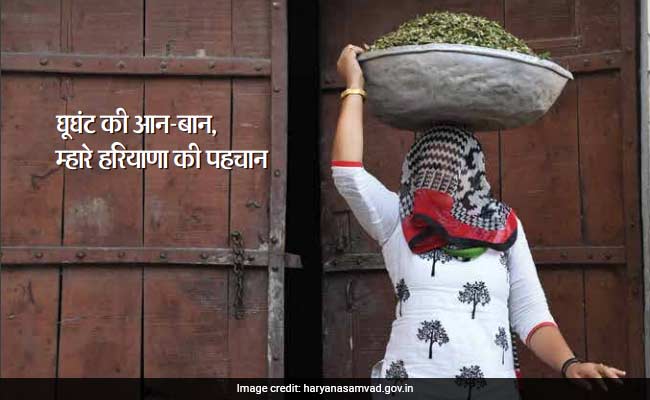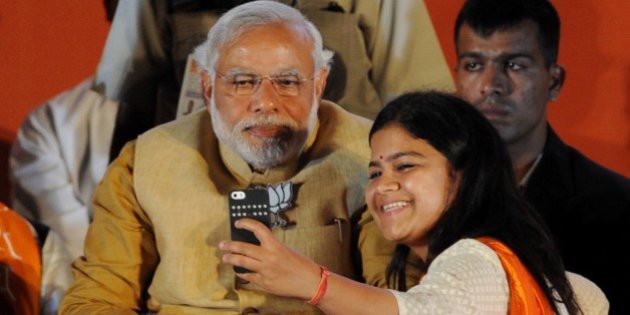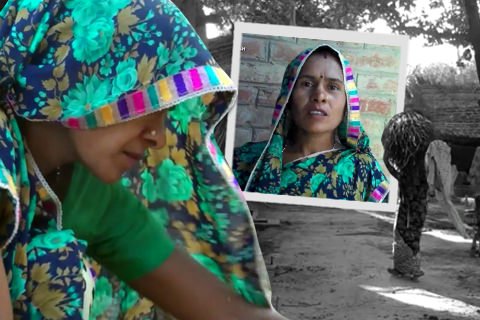Posted by Alankrita Anand and Madhura Chakraborty
In rural Uttar Pradesh, one woman challenges men to cover their faces with veils and then successfully execute their work.
Every morning Prabhawati goes about her daily household tasks, cleaning and feeding the cattle before she sets out for her job at the local Anganwadi (child care centre) in her village. Like many women from rural northern India she has her face covered when she’s doing this. This is normalised to such an extent, that it does not, at first glance, seem anything out of the ordinary but Prabhawati challenges this practice with vehemence in an on-camera conversation with Community Correspondent Mahesh Kumar: “Why don’t men wear veils too? What law exempts them from it? Let them wear veils and then they’ll understand our difficulties.”
Prabhawati talks about the taunts she has to endure if ever she is seen without the veil. “If I don’t cover my head, men will ridicule me saying that I’ve become a big leader“, she says. As an anganwadi worker, she has responsibilities outside the home as well. “When I go for a meeting, I cover my head, when I go to school to teach, I cover my head.” If she doesn’t, people from her community take it upon themselves to come to her home and inform her family about her ‘disrespectful transgression’.
This may seem shocking but the valorisation of patriarchal values and moral policing is unquestioningly adopted even by the state. Consider this: in the March issue of the journal Krishi Samvad, the Haryana government published a picture of a veiled woman captioned ‘a woman in a ghoonghat is the identity of Haryana’.

The March issue of Krishi Samvad which is published by the government of Haryana.
About two years ago, Sunil Jaglan a panchayat head from the Jind district of the same state had launched the ‘selfie with daughters’ campaign that was endorsed by the Prime Minister. The campaign which allows fathers to upload photos with their daughters has been hailed by the President as a praiseworthy effort to value daughters in a patriarchal society where early marriage and sex-selective abortions are very common. So on the one hand, there are campaigns like Beti Bachao, Beti Padhao (Save and Educate the Girl Child); on the other, it prides itself on having women in veils.

The ‘Selfie With Daughter’ campaign was seen as an initiative to celebrate daughters. Source: HuffPost
This is not surprising given that the government needs to meet certain human development goals by retaining girls in school, reducing the sex ratio imbalance. But the government is also run by people who have grown up in the same patriarchal society, internalising all its misogynist messages.
Prabhawati, and there are more women like her, have no illusions about the intent behind compelling women, through fear of shame and stigma, to practise purdah. In another part of Uttar Pradesh, Community Correspondent Usha Patel interviewed Manju Patel, a homemaker.
She doesn’t mince any words “One cannot be independent in the purdah. It is patriarchal fundamentalism that has been forcibly imposed on us. Men always want to keep women under their thumbs.” Prabhawati adds “Wisdom comes from seeing the world. You can only learn when you step out. I am expected to stay at home like a pet cat.” Pratima Dutta, a news anchor from a private news channel in Haryana, took this protest to another level when she appeared on camera, a veil covering her face, ridiculing the regressive stance of the government.
However, this is not the complete picture: some women defend the veil as a marker of modesty. Speaking to Community Correspondent Babita Maurya, Nagina Devi says that there will be no shame and dignity if the custom goes away. Clearly, the veil separates the good, modest, docile feminine subject valourised by patriarchy from the shameless ‘sluts’.
Internalising the chauvinistic logic of patriarchy is not limited to men, women also take the path of least resistance. Despite their strong opposition to it, Prabhawati and Manju are compelled to cover their faces. They do not have a support system that enables them to stick to their conviction, defying social mores. The price women pay for transgressing patriarchal diktats can be severe from being killed by their own families to being ostracised.
Veiling, purdah here and hijab somewhere else, is practised across the world. In the global context, the veiled Muslim woman has become a stereotyped singularity. Conservative and liberal religio-political stances are pinned on the opposing takes on the hijab. At the same time, women themselves speak out about their choice to practice veiling and their right to not do so. We hope that one day women like Prabhawati will be able to openly declare and practice their stated position on purdah without fear of violent patriarchal retributions.
Featured Image Credit: A still from the video
About the author(s)
Video Volunteers is a community media organisation that identifies, trains and empowers rural and marginalised people to make films, show the world their reality, assert their rights and become drivers of change. We work across 16 states with over 200 Community Corespondents 63 of whom exclusively work on reporting and taking action on everyday instances of patriarchal discrimination.




